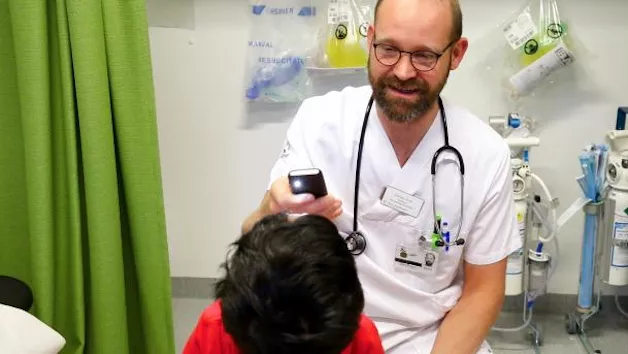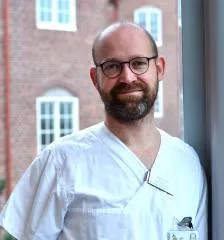Meet our researchers: all energies on fighting paediatric cancer
Outside the different examining rooms at paediatric oncology unit 64 hang laminated name signs with rainbows, unicorns and tractors that the young patients have made themselves. Each year, the unit receives around 60 new paediatric cancer patients from southern Sweden requiring examination or treatment. Of these, 85 per cent survive.
Kees-Jan Pronk shares his time between being a doctor in paediatric oncology at Skåne University Hospital, Lund, and being a researcher at Lund University. The children who come to unit 64 range from newborns up to 18 years of age. They come to the unit to receive cytostatic treatment or stem cell transplants. They often also need help with treatment-related complications. The cytostatic drugs that are used are very effective although also incredibly toxic for the body. Therefore, the children must sometimes also receive an antidote in conjunction with the treatment.
“We often use the world’s oldest cytotoxic drug, Methotrexate, including for acute lymphoblastic leukaemia (ALL), the most common form of cancer in children. Despite being in use since 1947, there are relatively few studies on the medicine. We do not know exactly how often or in which doses we should give the antidote or how the chemotherapy affects the kidney function of patients. This is therefore one of my research projects.”
Large group of children being studied
Although most children survive their cancer, many must pay a high price as they suffer from long-term complications. Doctors must think 30 - 40 years ahead and constantly adjust the medication in relation to its side effects. In a large Nordic study, in which Kees-Jan Pronk is involved, researchers are looking at the consequences for those children who received their treatment based on the Nordic treatment protocol for ALL.
“ALL has one of the highest survival rates and we cure over 90 per cent of all children in the Nordic countries, so now there is a really large patient group who have survived and who we can follow up. In Lund, we are responsible for researching how the kidneys have been affected by chemotherapy and how the immunological recovery takes place. In some patients, a stem cell transplant is required to be able to cure them. These patients receive very high doses of chemotherapy, sometimes in combination with total body radiation, to eliminate both the underlying disease but also the individual’s immune system. Subsequently, healthy blood-forming cells are transplanted from a donor, which regenerate the entire blood cell system. On a hunt for the same type of stem cells.
"The research helps me to gain a better understanding of how the body works and in my everyday clinical work I see where the problems are and which research issues are important."
Doctors first try to find identical stem cells in a sibling. If none are available, they keep looking in large international transplant registers. However, the donation process from a register takes two to three months and sometimes a patient does not have that time.
The solution is then to choose one of the parents as a donor – a so-called haploidentical stem cell transplant where haplo means half matched. However, the risk is then that the child’s immune system does not accept the new foreign stem cells and can reject them, while the newly transplanted cells can attack the patient – so-called graft versus host disease (GvH). Rejection and GvH are serious and sometimes life-threatening conditions.
“To avoid this, the immune cells in the patient are removed, as well as those in the donated cells being transplanted. It is complex, as the same cells are also needed to build up a new immune system. Without the immune cells, the child becomes extremely susceptible to viral diseases, among other things, and after a transplant, some children die from viruses that doctors cannot control.”
Research and everyday clinical work are connected
For Kees-Jan Pronk, questions about how the immune system regenerates following a haploidentical transplant and how it is possible to strengthen the immune defence are therefore an important part of his research.
“I think that clinical work and research enrich each other and for me personally, they are important to drive healthcare forward. The research helps me to gain a better understanding of how the body works and in my everyday clinical work I see where the problems are and which research issues are important.”
Text and photo in fact box: Åsa Hansdotter
Kees-Jan Pronk
Full name: Cornelis Jan Hendrik Pronk
Works: 50 per cent as a paediatric oncologist at Skåne University Hospital and 50 per cent in a clinical research position at the Wallenberg Centre for Molecular Medicine.
Age: 43
Family: wife Linda and two children, 12 and 15 years old
Originally from: Holland
Lives: On the Linderödsåsen ridge in Skåne
In his free time: spends time with the family, watches science fiction on Netflix and trains for triathlons.
Information about Kees-Jan Pronk in the Lund University Research Portal

